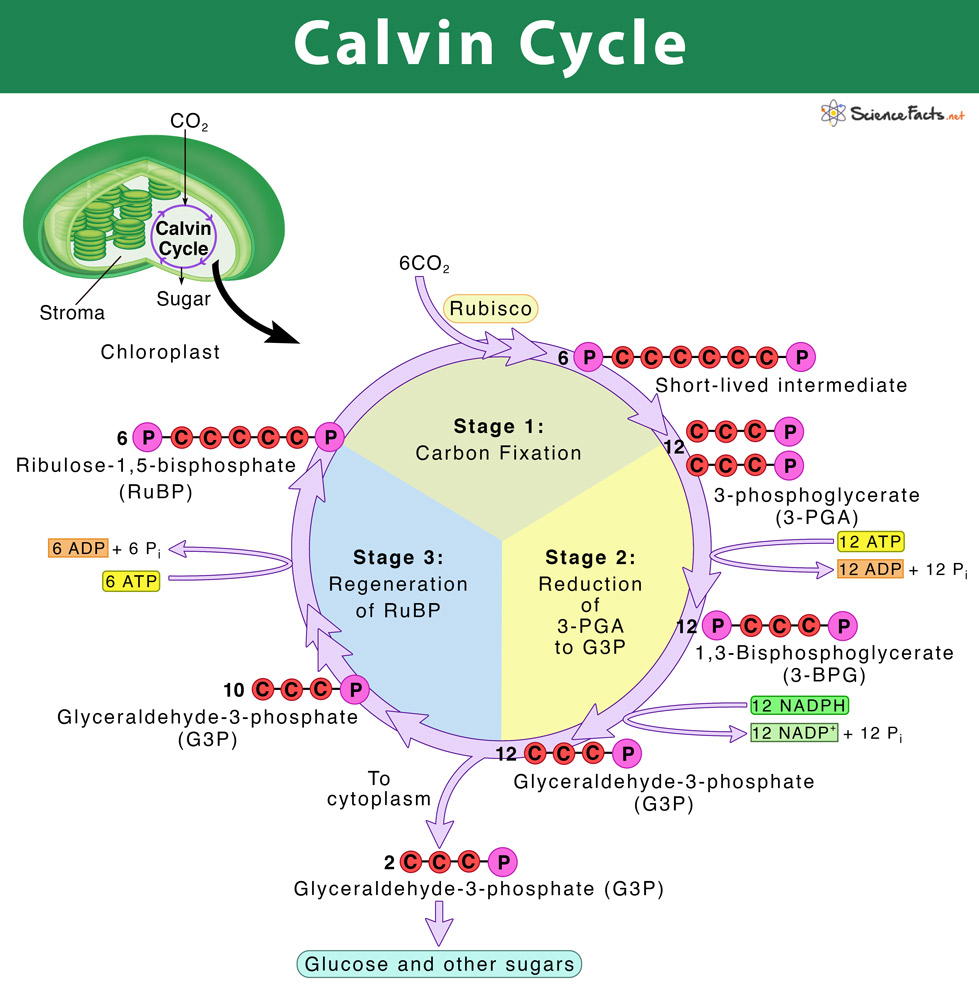In 1950, Melvin Calvin, James Bassham, and Andrew Benson discovered the Calvin cycle, thus also known as Calvin-Benson-Bassham (CBB) cycle.
What Happens In the Calvin Cycle and Where Does It Takes Place in Plants
Purpose of the Calvin Cycle
Steps
The three basic phases of the Calvin cycle are described below:
Stage 1: Carbon Fixation
It starts when carbon in the form of carbon dioxide enters through minute pores in the leaves called stomata, where they diffuse into the stroma of the chloroplast. Next, they combine with a five-carbon molecule ribulose-1,5-bisphosphate (RuBP) to form an unstable six-carbon intermediate that breaks down to form two 3-phosphoglyceric acid (3-PGA) molecules. This step of the Calvin cycle is catalyzed by the enzyme RuBP carboxylase/oxygenase, also known as rubisco.
Stage 2: Reduction
Using the energy from ATP, the three-carbon compound, 3-PGA molecules, produced in the carbon fixation stage, are converted into a three-carbon sugar glyceraldehyde-3-phosphate (G3P). This step involves the enzyme glyceraldehyde 3-phosphate dehydrogenase, in which NADPH from light reaction acts as the electron donor.
Stage 3: Regeneration
This is the final stage of the Calvin cycle that starts with G3P, the end product of the entire pathway. Some G3P is utilized in making glucose, while others are recycled to continue the cycle by combining with a carbon acceptor that turns into RuBP. The energy required to regenerate G3P is derived from ATP.
Reactants taking part in the Calvin cycle
CO2NADPHH2OATP
Its products
Glyceraldehyde-3-phosphate (the primary end product)NADP+ADP + PiADP
Enzymes involved in it
RuBP carboxylase/oxygenase or rubisco (convert ribulose-1,5-bisphosphate to 3-phosphoglyceric acid)Glyceraldehyde 3-phosphate dehydrogenase (convert 3-phosphoglyceric acid to glyceraldehyde-3-phosphate)
Chemical equation
3 CO2 + 6 NADPH + 5 H2O + 9 ATP → Glyceraldehyde-3-phosphate (G3P) + 6 NADP+ + 2 H++ 9 ADP + 8 Pi
Summary of the Calvin Cycle
Since six carbon atoms make a glucose molecule, it requires six turns of the Calvin cycle to produce one glucose molecule and three rounds to form a molecule of G3P. One molecule of G3P contains three fixed carbon atoms, so two G3P molecules are needed to form a glucose molecule. Among the six G3P molecules, five are utilized to regenerate RuBP, while the sixth molecule exits the cycle to make half of the glucose. Total Inputs and Outputs in Three Rounds of the Calvin Cycle
Fixed Carbon: Six molecules of glyceraldehyde-3-phosphate gets formed from three molecules of carbon dioxide and three RUBP molecules.Energy-Carriers Utilized: Nine ATP molecules are utilized and converted to nine ADP (six during the fixation step and three during the regeneration step), while six NADPH molecules are used up to produce six NADP+ during the reduction step.
Why is the Calvin Cycle also Called the C3 Cycle Plants that follow the above pathway to fix carbon are called C3 plants, which involve adding carbon dioxide to RUBP to form a three-carbon compound G3P. For example, rice, wheat, barley, cotton, and tobacco are all C3 plants.
Making the unavailable form of carbon present in the atmosphere as carbon dioxide into the useable form of glucose that acts as the source of food and energy in plants. All other organisms indirectly depend on plants for their food and survival. Forming the structural buildup in plants by preparing three-carbon sugar, that is utilized to make other sugars such as glucose, cellulose, and starch.The carbon backbones formed in the Calvin cycle make nucleic acids, lipids, protein, and all other building blocks of cells in plants and animals.
Other Functions
Maintaining the level of carbon dioxide, a greenhouse gas, in the atmosphere and thus keeping the earth’s temperature under control.Providing the source of energy for cellular respiration in plants. Helping to continue the carbon cycle in nature.Producing biofuels or carbon-neutral fuels that are environment-friendly.
